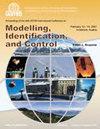A Novel Control Design for Realizing Passive Load-Holding Function on a Two-Motor-Two-Pump Motor-Controlled Hydraulic Cylinder
IF 0.9
4区 计算机科学
Q4 AUTOMATION & CONTROL SYSTEMS
引用次数: 0
Abstract
When a hydraulic cylinder connects two chambers directly to one or two hydraulic pumps driven by electric servo motors without any control valve in between, it can be called a motor-controlled hydraulic cylinder (MCC). Unlike valve-controlled cylinders, MCCs have no valve throttling, which significantly increases the energy efficiency. Among different MCC topologies, the two-motor-two-pump (2M2P) MCC has several advantages, such as cylinder pressure control and no mode switch oscillations. However, due to state coupling when controlling both piston position and minimum cylinder chamber pressure, the 2M2P MCC is a multi-input-multi-output (MIMO) system that usually requires advanced MIMO controller analysis and design. This paper presents a control algorithm for a 2M2P MCC with the minimum cylinder pressure control and passive load-holding function. This control algorithm is tested on a single-boom crane characterized by overrunning loads. It is designed based on the analysis of the system characteristics, requiring no MIMO controller analysis and design. A non-linear model of a single-boom crane driven by the proposed 2M2P MCC is created in MATLAB/Simulink and experimentally validated. Feedback controllers are designed and verified via simulations to realize position control, minimum cylinder pressure control, and load-holding under standstill command. For a given load and speed profile, the hydraulic system efficiency during pumping and motoring mode is 55-60 % and 20-25 %, respectively. The system’s overall efficiency can be enhanced with electrical regenerative drives, which feeds the generated power from potential energy to the grid or battery and reused in the next working cycle. The experimental results presented in this paper verifies the efficacy of the proposed control algorithm and demonstrates its superior performance in achieving the desired system response under various operating conditions.一种实现双电机-双泵马达控制液压缸被动负载保持功能的新型控制设计
本文章由计算机程序翻译,如有差异,请以英文原文为准。
求助全文
约1分钟内获得全文
求助全文
来源期刊

Modeling Identification and Control
工程技术-计算机:控制论
CiteScore
3.30
自引率
0.00%
发文量
6
审稿时长
>12 weeks
期刊介绍:
The aim of MIC is to present Nordic research activities in the field of modeling, identification and control to the international scientific community. Historically, the articles published in MIC presented the results of research carried out in Norway, or sponsored primarily by a Norwegian institution. Since 2009 the journal also accepts papers from the other Nordic countries.
 求助内容:
求助内容: 应助结果提醒方式:
应助结果提醒方式:


